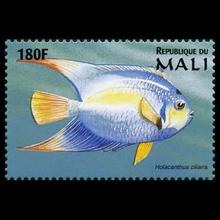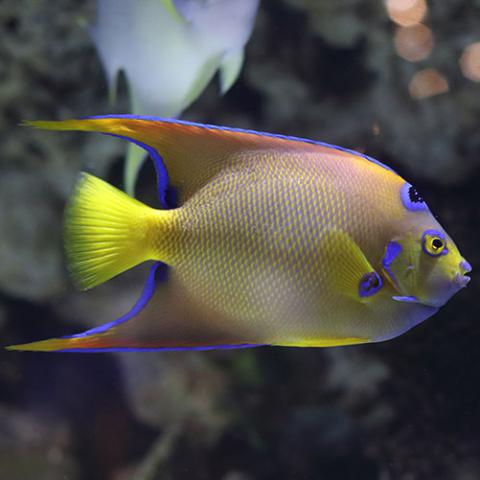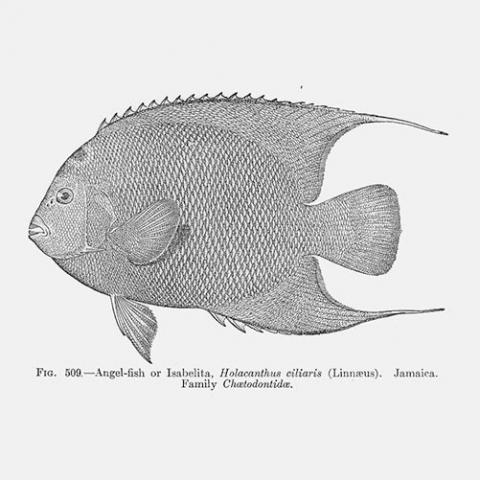NAMES
TAXONOMY
Mali
Issued:
Stamp:
Holacanthus ciliaris
Mali
Issued:
Stamp:
Holacanthus ciliaris
Mali
Issued:
Stamp:
Holacanthus ciliaris
Genus species (Animalia): Holacanthus ciliaris
The queen angelfish (Holacanthus ciliaris), also known as the blue angelfish, golden angelfish or yellow angelfish, is species of marine ray-finned fish, a marine angelfish belonging to the family Pomacanthidae. It is commonly found near reefs in the warmer sections of the western Atlantic Ocean.
Description
The queen angelfish has a deep, oval-shaped body which is strongly lateral compressed. It has a short snout with a small mouth which contains small teeth, like the bristles of a brush. The juveniles have a yellow anterior body turning brownish yellow halfway between the head and the vivid yellow caudal fin, the pectoral fin being a similar bright yellow. They are marked with a number of narrow white vertical stripes. The dorsal and anal fins have vivid blue margins. The adults have bluish yellow body with a yellow face and area of blue rings on the chest and forehead. They also have blue lips, yellow pectoral fins and caudal fins. The blue margined dorsal and anal fins have long yellow streamers extending rear wards from them. The distinctive vivid blue 'crown' on the forehead is the main feature distinguishing this species from the sympatric and rather similar Holocanthus bermudensis. The dorsal fin contains 14 spines and 19-21 soft rays while the anal fin has 3 spines and 20-21 soft rays. This species attains a maximum total length of 45 cm (18 in).
Distribution
Queen angelfish are found in the Western Atlantic Ocean. They occur from Florida south through the Caribbean Sea and Gulf of Mexico to the northern coast of South America. Its range extends as far east as Bermuda and Brazil’s St Paul’s Rocks.
Habitat and biology
Queen angelfish are benthic on coral reefs and it occurs from shallow waters close to the shore down to around 70 meters (230 ft). They are typically encountered either as solitary fish or as pairs, swimming among gorgonians and corals. Here they feed on a various invertebrates such as sponges, tunicates, jellyfish, and corals, and also on plankton and algae. Analysis of stomach contents has indicated that most of their diet comprises sponges. Juveniles act as cleaner fish and set up cleaning stations where they pick ectoparasites off bigger fish.
The adults may form a long-term monogamous pair bond. Each pair spawns by rising together upwards in the water, their abdomens almost touching. They then release their eggs and milt into the water. The female can lay between 25 and 75 thousand eggs in an evening and up to ten million eggs during each spawning season. The transparent eggs are pelagic and float in the water, hatching after 15-20 hours. The initial larvae have a large yolk sac and lack functional eyes, gut or fins but after 48 hours the yolk is absorbed and the larvae have more of a resemblance to normal fish. These larvae feed on plankton. In the waterand they grow rapidly and after around 3-4 weeks from hatching, when they have reached a length of 15 to 20 millimetres (0.59 to 0.79 in) they settle on the substrate.
Systematics
The queen angelfish was first formally described as Chaetodon ciliaris in 1758 in the 10th edition of his Systema Naturae by Carolus Linnaeus (1707-1778) with the type locality given as the “Western Atlantic/Caribbean”. Its specific name ciliaris means “fringed”, a reference to its squamis ciliatis which means “ciliate scales”. It is known to hybridise with its sympatric congener the rather similar blue angelfish (H. bermudensis), the hybrid offspring are not benthic and spend most of the day higher in the water column.
Utilization
The queen angelfish is common in the aquarium trade, and is the most frequently exported angelfish exported from Brazil. It is taken as a food fish on a small scale but consumption of its flesh is known to be a source of ciguatera poisoning.
Reference: Wikipedia



